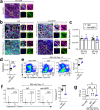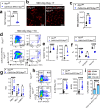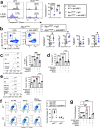Neuropilin 1 regulates bone marrow vascular regeneration and hematopoietic reconstitution
- PMID: 34848712
- PMCID: PMC8635308
- DOI: 10.1038/s41467-021-27263-y
Neuropilin 1 regulates bone marrow vascular regeneration and hematopoietic reconstitution
Abstract
Ionizing radiation and chemotherapy deplete hematopoietic stem cells and damage the vascular niche wherein hematopoietic stem cells reside. Hematopoietic stem cell regeneration requires signaling from an intact bone marrow (BM) vascular niche, but the mechanisms that control BM vascular niche regeneration are poorly understood. We report that BM vascular endothelial cells secrete semaphorin 3 A (SEMA3A) in response to myeloablation and SEMA3A induces p53 - mediated apoptosis in BM endothelial cells via signaling through its receptor, Neuropilin 1 (NRP1), and activation of cyclin dependent kinase 5. Endothelial cell - specific deletion of Nrp1 or Sema3a or administration of anti-NRP1 antibody suppresses BM endothelial cell apoptosis, accelerates BM vascular regeneration and concordantly drives hematopoietic reconstitution in irradiated mice. In response to NRP1 inhibition, BM endothelial cells increase expression and secretion of the Wnt signal amplifying protein, R spondin 2. Systemic administration of anti - R spondin 2 blocks HSC regeneration and hematopoietic reconstitution which otherwise occurrs in response to NRP1 inhibition. SEMA3A - NRP1 signaling promotes BM vascular regression following myelosuppression and therapeutic blockade of SEMA3A - NRP1 signaling in BM endothelial cells accelerates vascular and hematopoietic regeneration in vivo.
© 2021. The Author(s).
Conflict of interest statement
The authors declare no competing interests.
Figures







Similar articles
-
Neuropilin-1 Is an Important Niche Component and Exerts Context-Dependent Effects on Hematopoietic Stem Cells.Stem Cells Dev. 2017 Jan 1;26(1):35-48. doi: 10.1089/scd.2016.0096. Epub 2016 Nov 2. Stem Cells Dev. 2017. PMID: 27676403
-
SEMA3A partially reverses VEGF effects through binding to neuropilin-1.Stem Cell Res. 2017 Jul;22:70-78. doi: 10.1016/j.scr.2017.05.012. Epub 2017 Jun 3. Stem Cell Res. 2017. PMID: 28636974
-
Piezo1-mediated mechanosensation in bone marrow macrophages promotes vascular niche regeneration after irradiation injury.Theranostics. 2022 Jan 16;12(4):1621-1638. doi: 10.7150/thno.64963. eCollection 2022. Theranostics. 2022. PMID: 35198061 Free PMC article.
-
Dickkopf-1 promotes hematopoietic regeneration via direct and niche-mediated mechanisms.Nat Med. 2017 Jan;23(1):91-99. doi: 10.1038/nm.4251. Epub 2016 Dec 5. Nat Med. 2017. PMID: 27918563 Free PMC article.
-
Neuropilin regulation of angiogenesis, arteriogenesis, and vascular permeability.Microcirculation. 2014 May;21(4):315-23. doi: 10.1111/micc.12124. Microcirculation. 2014. PMID: 24521511 Free PMC article. Review.
Cited by
-
Significance of a Novel Angiogenesis-Related Biomarker Neuropilin-1 in Keloids.Mol Biotechnol. 2025 Jul 19. doi: 10.1007/s12033-025-01481-x. Online ahead of print. Mol Biotechnol. 2025. PMID: 40684009
-
The effects of semaphorin 3A in bone and cartilage metabolism: fundamental mechanism and clinical potential.Front Cell Dev Biol. 2023 Nov 23;11:1321151. doi: 10.3389/fcell.2023.1321151. eCollection 2023. Front Cell Dev Biol. 2023. PMID: 38078001 Free PMC article. Review.
-
Diverse roles for axon guidance pathways in adult tissue architecture and function.Nat Sci (Weinh). 2022 Oct;2(4):e20220021. doi: 10.1002/ntls.20220021. Epub 2022 Oct 2. Nat Sci (Weinh). 2022. PMID: 37456985 Free PMC article.
-
Epidermal growth factor augments the self-renewal capacity of aged hematopoietic stem cells.iScience. 2024 Jun 19;27(7):110306. doi: 10.1016/j.isci.2024.110306. eCollection 2024 Jul 19. iScience. 2024. PMID: 39055915 Free PMC article.
-
Phosphate Metabolic Inhibition Contributes to Irradiation-Induced Myelosuppression through Dampening Hematopoietic Stem Cell Survival.Nutrients. 2022 Aug 18;14(16):3395. doi: 10.3390/nu14163395. Nutrients. 2022. PMID: 36014901 Free PMC article.
References
Publication types
MeSH terms
Substances
Grants and funding
LinkOut - more resources
Full Text Sources
Medical
Molecular Biology Databases
Research Materials
Miscellaneous

